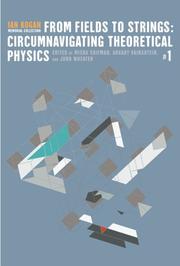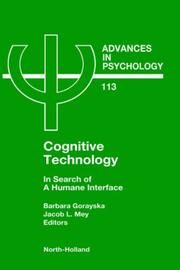| Listing 1 - 10 of 12 | << page >> |
Sort by
|
Book
ISBN: 1107127068 1107385172 1280414871 9786610414871 0511800460 0511202822 0511178697 0511077408 0511305907 0511075839 9780511077401 9780511800467 9781107385177 9780511202827 0521553741 9780521553742 0521556597 9780521556590 Year: 2003 Publisher: New York Cambridge University Press
Abstract | Keywords | Export | Availability | Bookmark
 Loading...
Loading...Choose an application
- Reference Manager
- EndNote
- RefWorks (Direct export to RefWorks)
The need to transmit and store massive amounts of data reliably and without error is a vital part of modern communications systems. Error-correcting codes play a fundamental role in minimising data corruption caused by defects such as noise, interference, crosstalk and packet loss. This book provides an accessible introduction to the basic elements of algebraic codes, and discusses their use in a variety of applications. The author describes a range of important coding techniques, including Reed-Solomon codes, BCH codes, trellis codes, and turbocodes. Throughout the book, mathematical theory is illustrated by reference to many practical examples. The book was first published in 2003 and is aimed at graduate students of electrical and computer engineering, and at practising engineers whose work involves communications or signal processing.
Data transmission systems --- Signal processing --- Data communication systems --- Transmission of data --- Digital communications --- Electronic data processing --- Electronic systems --- Information theory --- Telecommunication systems --- Mathematical models. --- Mathematics. --- Data transmission systems - Mathematical models --- Signal processing - Mathematics --- 681.3*E4 --- 681.3*I42 --- 681.3*I42 Compression (coding): approximate methods; exact coding (Image processing)--See also {681.3*E4} --- Compression (coding): approximate methods; exact coding (Image processing)--See also {681.3*E4} --- 681.3*E4 Coding and information theory: data compaction and compression; formal modelsof communication; nonsecret encoding schemes--See also {681.3*H11} --- Coding and information theory: data compaction and compression; formal modelsof communication; nonsecret encoding schemes--See also {681.3*H11} --- Mathematical models --- Mathematics

ISBN: 012620862X 9780126208627 9786611227319 1281227315 0080509258 9780080509259 9781281227317 6611227318 Year: 2006 Publisher: Amsterdam Boston Elsevier
Abstract | Keywords | Export | Availability | Bookmark
 Loading...
Loading...Choose an application
- Reference Manager
- EndNote
- RefWorks (Direct export to RefWorks)
Each edition of Introduction to Data Compression has widely been considered the best introduction and reference text on the art and science of data compression, and the third edition continues in this tradition. Data compression techniques and technology are ever-evolving with new applications in image, speech, text, audio, and video. The third edition includes all the cutting edge updates the reader will need during the work day and in class. Khalid Sayood provides an extensive introduction to the theory underlying today's compression techniques with detailed instruction for their app
Coding theory --- Data compression (Telecommunication) --- 681.3*E4 --- Compression of data (Telecommunication) --- Data compression (Computer science) --- Data transmission systems --- Digital electronics --- Information theory --- Machine theory --- Signal theory (Telecommunication) --- Computer programming --- 681.3*E4 Coding and information theory: data compaction and compression; formal modelsof communication; nonsecret encoding schemes--See also {681.3*H11} --- Coding and information theory: data compaction and compression; formal modelsof communication; nonsecret encoding schemes--See also {681.3*H11} --- Coding theory.
Book
ISBN: 9781107340718 9780521302326 9780521177382 9781461938187 146193818X 1107340713 9781107387201 1107387205 0521302323 1139886134 1107383595 1299820670 1107394821 1107298830 1107390036 1107398452 Year: 1984 Publisher: Cambridge [Cambridgeshire] New York, NY, USA Cambridge University Press
Abstract | Keywords | Export | Availability | Bookmark
 Loading...
Loading...Choose an application
- Reference Manager
- EndNote
- RefWorks (Direct export to RefWorks)
Originally published in 1981, this excellent treatment of the mathematical theory of entropy gives an accessible exposition of the ways in which this idea has been applied to information theory, ergodic theory, topological dynamics and statistical mechanics. Scientists who want a quick understanding of how entropy is applied in disciplines not their own, or simply desire a better understanding of the mathematical foundation of the entropy function will find this to be a valuable book.
Entropy (Information theory) --- Ergodic theory --- Statistical mechanics --- Topological dynamics --- 519.2 --- 536.75 --- 681.3*E4 --- 536.75 Entropy. Statistical thermodynamics. Irreversible processes --- Entropy. Statistical thermodynamics. Irreversible processes --- 519.2 Probability. Mathematical statistics --- Probability. Mathematical statistics --- Dynamics, Topological --- Differentiable dynamical systems --- Mechanics --- Mechanics, Analytic --- Quantum statistics --- Statistical physics --- Thermodynamics --- Ergodic transformations --- Continuous groups --- Mathematical physics --- Measure theory --- Transformations (Mathematics) --- Information theory --- 681.3*E4 Coding and information theory: data compaction and compression; formal modelsof communication; nonsecret encoding schemes--See also {681.3*H11} --- Coding and information theory: data compaction and compression; formal modelsof communication; nonsecret encoding schemes--See also {681.3*H11} --- Ergodic theory. --- Statistical mechanics. --- Topological dynamics.
Book
ISBN: 012491540X 9780080956220 008095622X 9786612755392 1282755390 9780124915404 Year: 1975 Volume: 113 Publisher: New York Academic Press
Abstract | Keywords | Export | Availability | Bookmark
 Loading...
Loading...Choose an application
- Reference Manager
- EndNote
- RefWorks (Direct export to RefWorks)
In this book, we study theoretical and practical aspects of computing methods for mathematical modelling of nonlinear systems. A number of computing techniques are considered, such as methods of operator approximation with any given accuracy; operator interpolation techniques including a non-Lagrange interpolation; methods of system representation subject to constraints associated with concepts of causality, memory and stationarity; methods of system representation with an accuracy that is the best within a given class of models; methods of covariance matrix estimation;methods for low-rank
Mathematical logic --- System analysis. --- Systèmes, Théorie des. --- System theory. --- Systèmes d'aide à la décision --- Decision support systems --- System Analysis --- System theory --- Théorie des systèmes --- ELSEVIER-B EPUB-LIV-FT --- Network analysis --- Network science --- Network theory --- Systems analysis --- Mathematical optimization --- System analysis --- 519.71 --- 681.3*H11 --- 519.71 Control systems theory: mathematical aspects --- Control systems theory: mathematical aspects --- 681.3*H11 Systems and information theory: value of information--See also {681.3*E4} --- Systems and information theory: value of information--See also {681.3*E4} --- Decision support systems. --- Systèmes d'aide à la décision --- Systèmes, Théorie des --- Theorie du controle
Book
ISBN: 9789490574901 Year: 2013 Publisher: Amsterdam Maven
Abstract | Keywords | Export | Availability | Bookmark
 Loading...
Loading...Choose an application
- Reference Manager
- EndNote
- RefWorks (Direct export to RefWorks)
Amazon raadt ons boeken aan, LinkedIn raadt ons banen aan en TomTom hoe om een file heen te rijden. Met dezelfde technologie berekent Google hoe virussen zich verspreiden, Twitter wie de verkiezingen gaat winnen en Shell waar ze het best naar olie kunnen boren.Aan de basis van deze ontwikkeling staan de explosieve groei aan digitale gegevens en de steeds krachtigere algoritmes waarmee we de gegevens onderzoeken. Het is inmiddels mogelijk om patronen en verbanden te ontdekken die het menselijk denkvermogen ver te boven gaan. In de toekomst - sneller dan we denken - zullen we op deze manier ook berekenen welke behandeling een patiënt moet krijgen, waar een inbraak gaat plaatsvinden en wie in aanmerking moet komen voor een promotie. We staan aan het begin van de big data-revolutie. En volgens experts gaat dit een grotere impact hebben op onze levens dan het internet.De big data-revolutie beschrijft een van de belangrijkste ontwikkelingen waar wij, onze kinderen en kleinkinderen, mee te maken krijgen. Voor eenieder die goed op de hoogte wil blijven van maatschappelijke en technologische ontwikkelingen is het verplichte kost.Bron : http://www.mavenpublishing.nl
Theory of knowledge --- Information systems --- gegevensopslag --- Documentation and information --- digitale technieken --- datacommunicatie --- digitale geheugens --- 330.3 --- ICT informatie- en communicatietechnologie --- data-analyse --- 681.3*E --- 681.3*E4 --- #SBIB:309H1720 --- #SBIB:35H24 --- #SBIB:303H520 --- 681.3*E Data --- Data --- 681.3*E4 Coding and information theory: data compaction and compression; formal modelsof communication; nonsecret encoding schemes--See also {681.3*H11} --- Coding and information theory: data compaction and compression; formal modelsof communication; nonsecret encoding schemes--See also {681.3*H11} --- dynamiek van de economie. Economische bewegingen --- Informatiekunde, informatie management --- Informatiemanagement bij de overheid --- Methoden sociale wetenschappen: techniek van de analyse, algemeen --- Statistische gegevens --- Maatschappelijke ontwikkelingen --- Technologie --- Praktijk --- Informatiemaatschappij --- Informatiemanagement --- Datamining --- Big Data --- Maatschappelijke ontwikkeling --- Sport --- Maatschappij --- 670 --- internet --- informatietechnologie --- informatica --- informatique
Book
ISBN: 9780124915503 0124915507 9786613838360 0080955770 1283525917 Year: 1970 Volume: 68 Publisher: New York ; London : Academic Press,
Abstract | Keywords | Export | Availability | Bookmark
 Loading...
Loading...Choose an application
- Reference Manager
- EndNote
- RefWorks (Direct export to RefWorks)
In this book, we study theoretical and practical aspects of computing methods for mathematical modelling of nonlinear systems. A number of computing techniques are considered, such as methods of operator approximation with any given accuracy; operator interpolation techniques including a non-Lagrange interpolation; methods of system representation subject to constraints associated with concepts of causality, memory and stationarity; methods of system representation with an accuracy that is the best within a given class of models; methods of covariance matrix estimation;methods for low-rank
Systems Analysis --- System analysis --- Analyse de systèmes --- 681.3*H11 --- Systems and information theory: value of information--See also {681.3*E4} --- 681.3*H11 Systems and information theory: value of information--See also {681.3*E4} --- Analyse de systèmes --- EPUB-LIV-FT ELSEVIER-B --- System analysis. --- Systems Analysis. --- Large scale systems. --- Systèmes, Analyse de. --- Systèmes de grandes dimensions. --- Niet-lineaire systemen. --- Nonlinear systems -- Mathematical models. --- Optimaliseren. --- Civil & Environmental Engineering --- Mathematics --- Physical Sciences & Mathematics --- Engineering & Applied Sciences --- Operations Research --- Mathematical Theory --- Nichtlineare Optimierung --- Hierarchisches System --- Nonlinear systems --- Niet-lineaire systemen --- Optimaliseren --- Mathematical models --- Systems, Nonlinear --- System theory --- System --- Nichtlineare Programmierung --- Nichtlineares Optimieren --- Nichtlineares Programmieren --- Nonlinear programming --- Optimierung --- Mathematical models. --- Systèmes, Analyse de. --- Systèmes de grandes dimensions.

ISBN: 0444703969 1322472262 1483296539 9781483296531 9780444703965 Year: 1988 Volume: 5 Publisher: Amsterdam, Netherlands : New York, New York : North Holland, Elsevier Science Publishing Company, Inc.,
Abstract | Keywords | Export | Availability | Bookmark
 Loading...
Loading...Choose an application
- Reference Manager
- EndNote
- RefWorks (Direct export to RefWorks)
This second volume is arranged in four sections: Analysis contains papers which compare the attributes of various approaches to uncertainty. Tools provides sufficient information for the reader to implement uncertainty calculations. Papers in the Theory section explain various approaches to uncertainty. The Applications section describes the difficulties involved in, and the results produced by, incorporating uncertainty into actual systems.
681.3*E4 --- 681.3*I23 --- Coding and information theory: data compaction and compression; formal modelsof communication; nonsecret encoding schemes--See also {681.3*H11} --- Deduction and theorem proving: answer/reason extraction; reasoning; resolution; metatheory; mathematical induction; logic programming (Artificial intelligence) --- 681.3*I23 Deduction and theorem proving: answer/reason extraction; reasoning; resolution; metatheory; mathematical induction; logic programming (Artificial intelligence) --- 681.3*E4 Coding and information theory: data compaction and compression; formal modelsof communication; nonsecret encoding schemes--See also {681.3*H11} --- Artificial intelligence. --- Problem solving. --- Uncertainty (Information theory) --- Measure of uncertainty (Information theory) --- Shannon's measure of uncertainty --- System uncertainty --- Information measurement --- Probabilities --- Questions and answers --- Methodology --- Psychology --- Decision making --- Executive functions (Neuropsychology) --- AI (Artificial intelligence) --- Artificial thinking --- Electronic brains --- Intellectronics --- Intelligence, Artificial --- Intelligent machines --- Machine intelligence --- Thinking, Artificial --- Bionics --- Cognitive science --- Digital computer simulation --- Electronic data processing --- Logic machines --- Machine theory --- Self-organizing systems --- Simulation methods --- Fifth generation computers --- Neural computers --- Artificial intelligence --- Knowledge Representation --- Uncertainty
Book
ISBN: 0444850090 0444850104 9786612769788 0080954235 1282769782 9780444850102 9780444850096 Year: 1977 Volume: 16 Publisher: Amsterdam
Abstract | Keywords | Export | Availability | Bookmark
 Loading...
Loading...Choose an application
- Reference Manager
- EndNote
- RefWorks (Direct export to RefWorks)
This book provides a comprehensive introduction to modern global variational theory on fibred spaces. It is based on differentiation and integration theory of differential forms on smooth manifolds, and on the concepts of global analysis and geometry such as jet prolongations of manifolds, mappings, and Lie groups. The book will be invaluable for researchers and PhD students in differential geometry, global analysis, differential equations on manifolds, and mathematical physics, and for the readers who wish to undertake further rigorous study in this broad interdisciplinary field.
Error-correcting codes (Information theory) --- Codes, Error-correcting (Information theory) --- Error-detecting codes (Information theory) --- Forbidden-combination check (Information theory) --- Self-checking codes (Information theory) --- Artificial intelligence --- Automatic control --- Coding theory --- Information theory --- 519.7 --- 681.3*E4 --- 519.7 Mathematical cybernetics --- Mathematical cybernetics --- 681.3*E4 Coding and information theory: data compaction and compression; formal modelsof communication; nonsecret encoding schemes--See also {681.3*H11} --- Coding and information theory: data compaction and compression; formal modelsof communication; nonsecret encoding schemes--See also {681.3*H11} --- Ergodic theory. Information theory --- Mathematical control systems --- Error-correcting codes (Information theory). --- Coding theory. --- Data compression (Telecommunication) --- Digital electronics --- Machine theory --- Signal theory (Telecommunication) --- Computer programming --- Codage --- Codes correcteurs d'erreurs (théorie de l'information)

ISBN: 1281347663 9786611347666 9812562524 9789812562524 9789812389558 9812389555 9789812387578 9812387579 9812560009 9812560017 9812561145 Year: 2004 Volume: v. 7 Publisher: River Edge, N.J. World Scientific
Abstract | Keywords | Export | Availability | Bookmark
 Loading...
Loading...Choose an application
- Reference Manager
- EndNote
- RefWorks (Direct export to RefWorks)
Watermarking techniques involve the concealment of information withina text or images and the transmission of this information to thereceiver with minimum distortion. This is a very new area ofresearch. The techniques will have a significant effect on defence,business, copyright protection and other fields where informationneeds to be protected at all costs from attackers.This book presents the recent advances in the theory andimplementation of watermarking techniques. It brings together, for thefirst time, the successful applications of intelligent paradigms(including comparisons with convent
Digital watermarking. --- Cryptography. --- Computer security. --- Data protection. --- Cryptanalysis --- Cryptology --- Secret writing --- Steganography --- Signs and symbols --- Symbolism --- Writing --- Ciphers --- Data encryption (Computer science) --- Watermarking, Digital --- Image steganography --- Watermarks --- Data governance --- Data regulation --- Personal data protection --- Protection, Data --- Electronic data processing --- Computer privacy --- Computer system security --- Computer systems --- Computers --- Cyber security --- Cybersecurity --- Electronic digital computers --- Protection of computer systems --- Security of computer systems --- Data protection --- Security systems --- Hacking --- Protection --- Security measures --- 681.3*E4 --- Digital watermarking --- Cryptography --- Computer security --- Filigrains --- Marks in paper --- Water-marks --- Marks of origin --- 681.3*E4 Coding and information theory: data compaction and compression; formal modelsof communication; nonsecret encoding schemes--See also {681.3*H11} --- Coding and information theory: data compaction and compression; formal modelsof communication; nonsecret encoding schemes--See also {681.3*H11} --- Data processing --- Particles (Nuclear physics) --- Condensed matter. --- String models. --- Particules (Physique nucléaire) --- Matière condensée --- Modèles des cordes vibrantes (Physique nucléaire) --- Kogan, Ian I. --- Data processing.

ISBN: 0444822755 9786611055332 1281055336 0080529313 9780444822758 9780080529318 Year: 1996 Publisher: Amsterdam Elsevier
Abstract | Keywords | Export | Availability | Bookmark
 Loading...
Loading...Choose an application
- Reference Manager
- EndNote
- RefWorks (Direct export to RefWorks)
In this book the editors have gathered a number of contributions by persons who have been working on problems of Cognitive Technology (CT). The present collection initiates explorations of the human mind via the technologies the mind produces. These explorations take as their point of departure the question What happens when humans produce new technologies? Two interdependent perspectives from which such a production can be approached are adopted: How and why constructs that have their origins in human mental life are embodied in physical environments when people fabricate their hab
Artificial intelligence. --- Cognition --- Cognitive science --- Human information processing --- 130.2:6 --- 165.23 --- 681.3*H11 --- AI (Artificial intelligence) --- Artificial thinking --- Electronic brains --- Intellectronics --- Intelligence, Artificial --- Intelligent machines --- Machine intelligence --- Thinking, Artificial --- Bionics --- Digital computer simulation --- Electronic data processing --- Logic machines --- Machine theory --- Self-organizing systems --- Simulation methods --- Fifth generation computers --- Neural computers --- Information processing, Human --- Information theory in psychology --- Perception --- Science --- Philosophy of mind --- Psychology --- 165.23 Kennis: begripsanalyse naar woordbetekenis; betekeningsvraagstuk --- Kennis: begripsanalyse naar woordbetekenis; betekeningsvraagstuk --- 681.3*H11 Systems and information theory: value of information--See also {681.3*E4} --- Systems and information theory: value of information--See also {681.3*E4} --- 130.2:6 Filosofie van de cultuur. Cultuurfilosofie. Cultuursystemen. Kultuurfilosofie-:-Biomedische wetenschappen. Ingenieurswetenschappen. Computerwetenschap. Grafische industrie. Uitgeverij --- Filosofie van de cultuur. Cultuurfilosofie. Cultuursystemen. Kultuurfilosofie-:-Biomedische wetenschappen. Ingenieurswetenschappen. Computerwetenschap. Grafische industrie. Uitgeverij --- Artificial intelligence --- Philosophy and cognitive science. --- Technology --- Human-machine systems. --- Human information processing. --- Human operators (Systems engineering) --- Human subsystems (Systems engineering) --- Man-machine control systems --- Man-machine systems --- Operator-machine systems --- Engineering systems --- Human engineering --- Technology and civilization --- Cognitive science and philosophy --- Philosophy.
| Listing 1 - 10 of 12 | << page >> |
Sort by
|

 Search
Search Feedback
Feedback About UniCat
About UniCat  Help
Help News
News